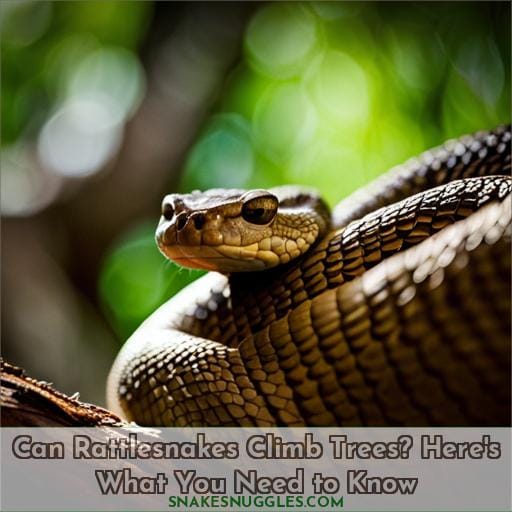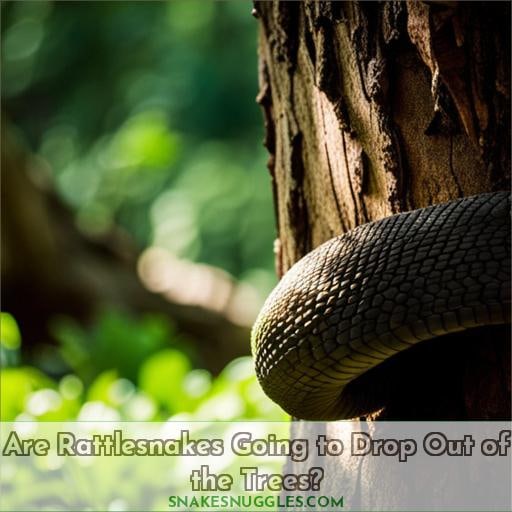This site is supported by our readers. We may earn a commission, at no cost to you, if you purchase through links.
 As chance would have it, rattlesnakes are capable of climbing trees. But questions remain as to why they do so and how high they can go?
As chance would have it, rattlesnakes are capable of climbing trees. But questions remain as to why they do so and how high they can go?
To answer these queries and more, we explore the behavior of arboreal Black-tailed Rattlesnakes in this article. We’ll look at the types of surfaces that rattlesnakes cling to with their specialized scales and what drives them up into the branches in search for food or shelter.
You’ll also learn that many harmless nonvenomous snakes are much better climbers than rattlesnake species since not all varieties share this ability – some preferring rocks or shrubs instead – plus find out whether walls present an even greater challenge for a slithering snake’s ascent!
Table Of Contents
Key Takeaways
- Rattlesnakes can climb trees, rocks, and textured surfaces.
- They struggle on smooth vertical surfaces like walls or fences.
- Snake fencing is effective against climbing snakes.
- Snake fencing should be at least 36 inches high and professionally installed.
The Basics: What is a Snake Fence?
Protecting your home from dangerous rattlesnakes is made easier with proper snake fencing – a barrier designed to keep them out and keep you safe. Fencing materials should be smooth steel mesh with the appropriate gap size for effective exclusion of climbing snakes.
Rattlesnakes struggle on vertical surfaces, so fences need not exceed 36 inches in height. Additionally, an added buffer should be included to account for variations in length among species. Installation requires specialist knowledge. Reputable companies will have qualifications and insurance, as well as customer support for removal or inquiries about the fence design.
Proper installation involves securing screws into existing structures, while also taking aesthetics into consideration. Repellents are ineffective, but adding extra buffers may discourage non-venomous snakes from trying to access enclosed areas near native habitats where the risk of encountering rattlesnakes is highest.
Rattlesnake Fencing Isn’t as Simple as It Seems
Installing a rattlesnake fence is more complex than it seems – you’ll need an expert’s eye and knowledge for the job. Adequate height, quality materials, and professional expertise are essential to ensure your snake fencing does its job effectively.
For starters, sufficient fencing should be at least 36 high with additional buffer to account for variations in terrain or species like the black-tailed rattlesnake that can reach up to 6 feet long! Furthermore, smooth steel mesh with the proper gap size must be used as snakes cannot climb vertically on smooth surfaces – however, they may attempt ascension of trees or rocks.
Lastly, but certainly not least, gate barriers should be installed properly by experts as part of their relocation services while ensuring aesthetics aren’t compromised along the way! With all these considerations taken into account before installation begins, you’re well on your way towards effectively snake-proofing any desired area!
Are Rattlesnakes Going to Drop Out of the Trees?
When it comes to safeguarding your home, you might be wondering if those rattlesnakes in the trees are going to come down and cause trouble. To avoid snakes, it’s important to know how they climb and what preventative measures can be taken.
The Western Diamondback Rattlesnake is commonly spotted in trees for basking or hunting prey due to its ability to reach higher areas where food may hide. However, their climbing skills vary between species. Some struggle on smooth vertical surfaces, while others use lateral undulation or concertina mode depending on the tree’s texture.
Snake repellents don’t work. A durable snake fencing system with a 36 height is necessary for effective protection against these dangerous animals. Gate installation should not be neglected either, according to expert standards, along with proper material attachment to existing structures such as walls or fences.
It’s also helpful to watch videos online about snake identification behavior when living near native habitat, as this increases the risk of encountering them outdoors or even inside houses at times.
| Avoiding Snakes | Snake Identification | Snake Repellents |
|---|---|---|
| Preventive Measures | Tree Climbing | Species Behavior |
| Prey Access | Western Diamondback Rattlesnake | |
| Snake Videos |
What Kinds of Rattlesnakes Climb?
Have you ever wondered if rattlesnakes can climb? While the idea of a dangerous snake slithering up a tree might be daunting, it’s important to understand their capabilities and limitations when it comes to climbing.
Rattlesnakes are arboreal creatures, which means they can climb trees, rocks, and other textured surfaces but struggle on smooth vertical surfaces such as walls or fences.
Are There Arboreal Rattlesnakes?
Yes, there are some species of rattlesnakes that can scale trees with their impressive climbing abilities. Timber Rattlesnakes and Coachwhips have been observed using lateral undulation and concertina mode to navigate arboreal surfaces.
To deter these tree-climbing snakes from entering enclosed areas, specialized snake fencing experts should be sought for reliable installation. These designs must account for the snake’s hibernation habits, venom production capabilities, diet preferences, and mating rituals when selecting a suitable habitat.
Smooth steel mesh with the proper gap size is ideal to avoid climbing, as rattlesnakes struggle on vertical surfaces but may ascend textured or rocky terrain if given enough traction points and leverage in movement patterns advised by knowledgeable snake experts!
Why Might a Rattlesnake Climb?
Exploring the behavior of rattlesnakes in trees can help you better understand why they might ascend to these heights and how to design efficient deterrents. Rattlesnakes may climb for many reasons: foraging habits, denning sites, birthing sites, thermal regulation, or prey selection.
They are able to climb trees, as well as walls and textured surfaces; however, smooth vertical surfaces pose more difficulty. Knowing their capabilities is vital when considering predator avoidance strategies, such as fencing, that will be effective against this species of snake.
An understanding of rattlesnake behavior, combined with proper installation techniques, creates a safer environment without sacrificing aesthetics or customer support options should removal become necessary.
How Do Rattlesnakes Climb?
You can witness a rattlesnake’s ability to scale almost anything when it wants to. Rattlesnakes use two main forms of climbing: lateral undulation and concertina mode. Lateral undulation is used for rough surfaces like trees, while the concertina method works on vertical walls or smooth surfaces they can’t scale otherwise.
Timber rattlesnakes and slim species such as coachwhips are agile climbers, though their success depends on surface texture and gaps in the fence installation. While cottonmouths may climb occasionally, this behavior is rare and not common among venomous snakes; hence, these myths should be avoided since snake fencing is essential for safety from dangerous species.
Can Rattlesnakes Climb Walls?
Feel the fear as you glance up and see a rattlesnake scaling your wall! Rattlesnakes can, in fact, climb walls with the use of their lateral undulation or concertina mode. However, they are not typically successful on smooth vertical surfaces due to their scale structure.
Snake-proof fencing should be installed by experienced specialists to prevent climbing. This includes fences that are at least 36” high and made from steel mesh with properly sized gaps between them.
Tree-climbing species such as timber rattlesnakes or slim coachwhips may also necessitate extra precautions against entry into enclosed spaces like homes near native habitats. Basking, prey hunting, and refuge seeking have all been identified as reasons for snake climbing behavior.
However, appropriate deterrents must still be put in place for safety’s sake. This can be achieved through snake gate solutions recommended by skilled professionals who understand both aesthetic considerations and customer support requirements when tackling these creatures’ presence nearby our own environments.
How High Can a Rattlesnake Climb?
Considering their climbing capabilities, it’s important to factor in how high rattlesnakes can ascend when designing an effective deterrent. While timber and other slim species are capable of tree-climbing, they struggle on loose surfaces or smooth vertical walls.
The Blacktailed Rattlesnake reportedly climbs up to 6 feet high onto man-made structures such as fence posts or trees. Protective solutions must be tailored based on snake behavior rather than repellents, which offer limited deterrence at best.
As a result, expertise from rattlesnake experts is highly recommended over pest control companies for reliable prevention and customer support if needed. Knowing more about these creatures’ biology helps create better protective solutions against them.
Frequently Asked Questions (FAQs)
How effective is rattlesnake fencing?
Rattlesnake fencing is highly effective, blocking their entry into enclosed areas. Smooth steel mesh with the right gap size deters climbing, and experts recommend a height of 36 for optimal protection.
Durable installation ensures long-lasting results, while aesthetic considerations are also important to consider.
Is it necessary to have an expert install a snake fence?
Do you want to protect yourself and your home from dangerous rattlesnakes? An expert installation is necessary for effective snake fencing – ensuring safety, aesthetics, and expertise. Don’t risk it with just any service provider; seek out a reputable company certified in this field.
What is the most common type of rattlesnake found in trees?
The most common type of rattlesnake found in trees is the Timber Rattlesnake and slim species such as Coachwhips. These snakes use lateral undulation or concertina mode to ascend, although they struggle on smooth vertical surfaces.
Basking, prey hunting, refuge, and exploration are potential reasons for their tree-climbing behavior.
Are there any alternatives to using a snake fence?
Alternatives to snake fencing include using motion-activated sprinklers and lights, as well as keeping vegetation trimmed. These options may help deter snakes from entering an area but won’t provide the same level of protection that a fence would.
Additionally, it is important to keep potential entry points sealed off or inaccessible. Taking these steps can help protect against dangerous species while respecting their role in ecosystems.
What are the signs of a rattlesnake being in the area?
Signs of rattlesnakes in the area include their distinctive rattle, telltale tracks, and sightings of adults or juveniles. Look out for shed skins too, which are a metaphor for regeneration and transformation.
Conclusion
No matter how much you try to avoid them, rattlesnakes are a part of life. As such, it pays to know the facts. While rattlesnakes can climb trees, rocks, and textured surfaces, their ability to climb smooth vertical surfaces is usually limited.
To truly protect yourself and your property from these dangerous species, you must invest in a proper snake fence. This should be designed with specialist knowledge and installed with expert help to ensure its effectiveness.
With the right fencing and a bit of respect for rattlesnakes, you can enjoy a safe, snake-free outdoor space. So, don’t be afraid to let caution be your guide – when it comes to keeping rattlesnakes away, knowledge is your best weapon.










